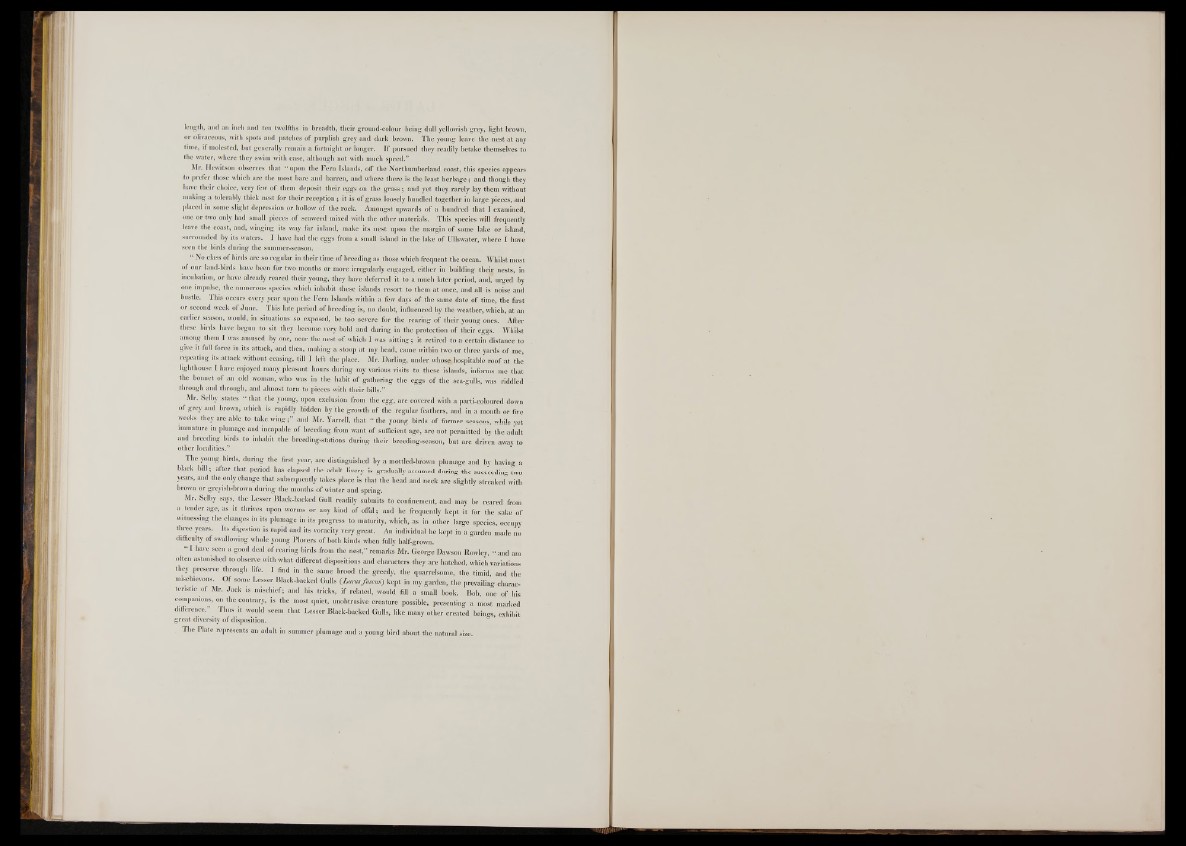
length, and an inch and ten twelfths in breadth, their ground-colour being dull yellowish grey, light brown,
or olivaceous, with spots and patches o f purplish grey and dark brown. The young leave the nest at any
time, if molested, but generally remain a fortnight or longer. I f pursued they readily betake themselves to
the water, where they swim with ease, although not with much speed.”
Mr. Hewitson observes that “ upon the Fern Islands, off the Northumberland coast, this species appears
to prefer those which are the most bare and barren, and where there is the least herbage; and though they
have their choice, very few o f them deposit their eggs on the grass; and yet they rarely lay them without
making a tolerably thick nest for their reception ; it is o f grass loosely bundled together in large pieces, and
placed in some slight depression or hollow o f the rock. Amongst upwards o f a hundred that I examined,
one or two only had small pieces of seaweed mixed with the other materials. This species will frequently
leave the coast, and, winging its way far inland, make its nest upon the margin of some lake or island,
surrounded by its waters. I have had the eggs from a small island in the lake of Ullswater, where I have
seen the birds during the summer-season.
“ No class o f birds are so regular in their time o f breeding as those which frequent the ocean. Whilst most
of our land-birds have been for two months or more irregularly engaged, either in building their nests, in
incubation, or have already reared their young, they have deferred it to a much later period, and, urged by
one impulse, the numerous species which inhabit these islands resort to them at once, and all is noise and
bustle. This occurs every year upon the Fern Islands within a few days o f the same date o f time, the first
or second week of June. This late period o f breeding is, no doubt, influenced by the weather, which, at an
earlier season, would, in situations so exposed, be too severe for the rearing o f their young ones. After
these birds have begun to sit they become very bold and daring in the protection o f their eggs. Whilst
among them I was amused by one, near the nest o f which I was sitting; it retired to a certain distance to
give it full force in its attack, and then, making a stoop at my head, came within two or three yards o f me,
repeating its attack without ceasing, till I left the place. Mr. Darling, under whos§>hospitable roof at the
lighthouse I have enjoyed many pleasant hours during my various visits to these islands, informs me that
the bonnet o f an old woman, who was in the habit o f gathering the eggs of the Sea-gulls, was riddled
through and through, and almost torn to pieces with their bills.”
Mr. Selby states “ that the young, upon exclusion from the egg, are covered with a parti-coloured down
o f grey and brown, which is rapidly hidden by the growth of the regular feathers, and in a month or five
weeks they are able to take wing;” and Mr. Yarrell, that “ the young birds o f former seasons, while yet
immature in plumage and incapable of breeding from want o f sufficient age, are not permitted by the adult
and breeding birds to inhabit the breeding-stations during their breeding-season, but are driven away to
other localities.”
The young birds, during the first year, are distinguished by a mottled-brown plumage and by having a
black bill; after that period has elapsed the adult livery is gradually assumed during the succeeding two
years, and the only change that subsequently takes place is that the head and neck are slightly streaked with
brown or greyish-brown during the months o f winter and spring.
Mr. Selby says, the Lesser Black-backed Gull readily submits to confinement, and may be reared from
a tender age, as it thrives upon norms or any kind o f offal; and he frequently kept it for the sake of
witnessing the changes in its plumage in its progress to maturity, which, as in other large species, occupy
three years. Its digestion is rapid and its voracity very great. An individual he kept in a garden made no
difficulty o f swallowing whole young Plovers of both kinds when fully half-grown.
" I have seen a good deal o f rearing birds from the nest,” remarks Mr. George Dawson Rowley, “ and am
often astonished to observe with what different dispositions and characters they are hatched, which variations
they preserve through life. I find in the same brood the greedy, the quarrelsome, the timid, and the
mischievous. Of some Lesser Black-backed Gulls (Larmfusous) kept in my garden, the prevailing charac-
tenstic o f Mr. Jack is mischief; and his tricks; i f related, would fill a sm # |b o o k . Bob, one o f his
companions, on the contrary, is the most quiet, unobtrusive creature possible, presenting a most marked
difference.” Thus it would seem that Lesser Black-baeked Gulls, like many other created beings, exhibit
great diversity o f disposition.
The Plate represents an adult in summer plumage and a young bird about the natural size.